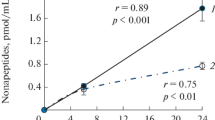Summary
Incubation of human serum or plasma at 37°C leads to the formation of a non-dialysable vasoactive factor, which we have called active pressor principle (APP). The intravenous injection of incubated human serum into anesthetized ganglionic blocked rats causes a transient blood pressure increase similar to the response to angiotensin II. The pressure activity of incubated serum or plasma depends on temperature and time of the incubation. At 37 °C the activity reaches a maximum within 6 days. A slight decrease occurs after further incubation. At 4 °C very little APP is formed within several weeks; at 25 °C a maximum is reached after about 14 days of incubation. Incubation at 47 °C yields a maximum activity after 48 hours; further incubation induces a marked decrease in APP-concentration.
During incubation of serum at 37 °C after addition of angiotensin II or noradrenaline, these substances are rapidly inactivated, whereas the APP-formation proceeds uninfluenced. After separation by means of gel filtration with
Zusammenfassung
Inkubation von sterilem menschlichem Serum oder Plasma bei 37 °C führt zur Entstehung eines nichtdialysablen Faktors, den wir als aktives pressorisches Prinzip (APP) bezeichnet haben. Intravenöse Gabe von inkubiertem Humanserum an narkotisierte gangliengeblockte Ratten ruft eine Blutdruckantwort hervor, die jener auf Angiotensin II und Noradrenalin ähnlich ist. Die pressorische Aktivität von Serum bzw. Plasma ist von Inkubationszeit und Temperatur abhängig. Bei 37 °C wird die maximale Aktivität nach 6 Tagen Inkubation erreicht; weitere Inkubation führt zu einer geringfügigen Aktivitätsabnahme. Bei 4 °C ist selbst nach mehreren Wochen nur wenig APP nachweisbar; bei 25 °C tritt ein Aktivitätsmaximum nach ca. 14 Tagen auf. Inkubation bei 47 °C liefert eine Maximalaktivität nach etwa 48 Studen, gefolgt von einem deutlichen Aktivitätsverlust.
Bei Inkubation von Serum bei 37 °C nach Zugabe von Angiotensin II oder Noradrenalin werden diese Substanzen rasch inaktiviert, während die APP-Bildung unbeeinflußt vor sich geht. Nach Gelfiltration auf Sephadex G-200 ist die gesamte pressorische Aktivität in der Fraktion nachzuweisen, der die hauptmenge an Albumin angehört. Es kann daher angenommen werden, daß APP entweder selbst ein Protein ist oder aber eine Substanz, die an ein Trägerprotein gebunden ist. Die Eigenschaften von APP schließen eine Identität mit Angiotensin II oder Noradrenalin aus.
Similar content being viewed by others
References
Arneil, G. C., J. B. Dekanski: Excess of vasopressor activity in plasma of nephritic children with hypertension. Lancet1954/II, 1204–1207.
Masson, G. M. C., G. Helmcke, A. C. Corcoran, I. H. Page: Pressor and myotrophic activities of incubated plasma. Proc. Soc. exp. Biol. Med.94, 544–546 (1957).
Khairallah, P. A., I. H. Page: A vasopressor lipid in incubated plasma. Amer. J. Physiol.199, 341–345 (1960).
Kenner, T., W. Waldhäusl: A non-dialysable, heat-stabile, hypertensive substance in the serum of rats. Nature204, 581–582 (1964).
Kenner, T., W. Waldhäusl: Zur Frage eines extrarenalen pressorischen Systems. Pflügers Arch.281, 50 (1964).
Kenner, T., W. Waldhäusl: Zur biologischen Bedeutung des nach mehrstündiger Erwärmung in Serum und Plasma nachweisbaren pressorischen Prinzips. Z. Kreislaufforschg.54, 1143–1148 (1965).
Waldhäusl, W., T. Kenner: Über die Entstehung einer nicht-dialysierbaren vasopressorischen Aktivität durch Erwärmung von Serum. Med. Pharmacol. exp.12, 388–394 (1965).
Peterlik, M., W. Waldhäusl: Isolation of a non-dialysable active pressor principle from pig serum. Nature214, 279 (1967).
Croxatto, H., J. Roblero, M. Ossio: Substancias vasopresoras formadas en el suero sanguineo por incubacion a 38 °C a pH normal. Arch. Biol. Med. Exper.2, 55–62 (1965).
Armstrong, D., H. Croxatto, J. Roblero: Characteristics of spontaneous formation of vasopressor principle (VA) and of plasma kinin as released by temperature changes, in: Advances in experimental medicine and biology (N. Back andF. Sicuteri, Eds.) Vol. 21, Vasopeptides; pp. 58–56; Plenum Press, 1972.
Croxatto, H., H. Cruzatt: Ineffectiveness of Carboxypeptidase B in inhibiting the pressor effect of incubated human plasma. Experientia25, 59–60 (1969).
Croxatto, H., G. Diaz: Adrenergic receptor blockers on pressor activity of incubated human plasma. Proc. Soc. exp. Biol. Med.130, 465–469 (1969).
Roblero, J., H. Croxatto: Vasoactive substances formed in blood serum by incubation at 37 °C normal pH, in: International Symposium on vasoactive polypeptides: Bradykinin and related kinins (M. Rocha, E. Silva andH. A. Rothschild, Eds.), pp. 119–125, III. Internat. Pharmacolog. Congress and Soc. Bras. Farmacologia e Terapeutica Experimental (SBFTE) (São Paulo, Brazil, 1967).
Roblero, J., H. Croxatto: Vasoactive substances formed in blood serum by incubation. N.Y.St. J. Med.68, 235–242 (1968).
Gordon, D. B., C. L. Rieske: Arneil factor: A pressor substance, probably a protein, in incubated plasma. Fed. Proc.26, 378 (1967).
Hertlein, E., T. Kenner, P. Dördelmann: Häufigkeitsverteilung der Aktivität eines nicht-dialysierbaren pressorischen Faktors im Plasma von nichtschwangeren und schwangeren Frauen. Z. Kreislaufforschg.58, 755–758 (1969).
Dahlheim, H.: Personal communication (1976).
Wurm, H., H. Dowertil, E. Zierler, T. Kenner: Properties of an unidentified non-dialysable vasopressor factor in human serum and plasma. Pflügers Arch.359, R 35 (1975).
Wurm, H., T. Kenner, V. Bauer, E. Zierler: Influence of adrenergic and ganglionic blockers and of nephrectomy in rats on vasopressor response to i.v. administration of incubated human serum. Pflügers Arch.362, R 6 (1976).
Author information
Authors and Affiliations
Additional information
With 4 figures and 1 table
Rights and permissions
About this article
Cite this article
Wurm, H., Kenner, T. Some properties of a high molecular vasopressor substance generated in human Serum by incubation. Basic Res Cardiol 73, 1–9 (1978). https://doi.org/10.1007/BF01914651
Received:
Issue Date:
DOI: https://doi.org/10.1007/BF01914651



